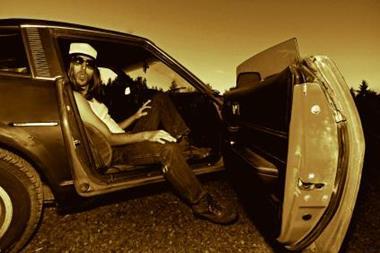Keys that monitor speed and alcohol intake, buzzers that keep drivers in the right lane and, eventually, cars that drive themselves. Our designated driver tries out the latest safety technology set to save lives, reduce injuries and cut the cost of accidents for insurers
The speedometer is climbing steadily – 80, 90, 100mph. I feel like Jeremy Clarkson minus the jeans and cowboy boots. The stereo is pumping out R&B, but in my head Queen is playing ‘Don’t Stop Me Now’, which I later discover was once voted the ultimate driving track by viewers of Top Gear. Reaching the end of the runway, I slow the car and prepare to have another run.
I’m at a former US Air Force base in Oxfordshire. On all sides of the airfield are the drum-shaped hangars that once housed F16 fighter jets. But today is all about futuristic cars: vehicles that could bring about a quantum leap in road safety and revolutionise the way that car insurance works. The event has been set up by Thatcham, a not-for-profit organisation that carries out research aimed at reducing the cost of accident claims for insurance companies.
Teen spirit
I’m driving a Ford Taurus, a powerful saloon only available in the USA. And yet its transmission key technology offers a potential solution to parents worried that an 18-year-old son isn’t quite ready to be trusted with the car. For the Ford Taurus offers a ‘youth key’ that can be programmed for a young driver – what Ford calls MyKey. Currently available only in the USA, it is likely to arrive in the UK soon.
My second run shows me the difference. This time the conventional key is replaced with the youth key. I pull up my imaginary hoodie, adjust my invisible baseball cap and begin revving. Here we go. The car accelerates off, I crank up the stereo. But that’s when my teenage self senses something is wrong. The volume goes halfway up and then no further. Ditto the speedometer: when I hit 80mph, the car refuses to accelerate. In other words, the youth key limits what the driver can do. I discover later that it won’t even let you play the stereo if you’re not wearing a seatbelt.
Young drivers present a huge risk to insurers. Car crashes are the single biggest cause of death for the under-25s, with excess speed the cause in 41% of fatalities where young men are driving. But it’s not just young people who need protecting. It’s easy to forget that 2,500 people die on the roads every year in the UK. So manufacturers, motivated by government targets, see technology as a crucial ingredient in bringing the number of fatalities down.
Thatcham crash research manager Matthew Avery says the evidence of technology’s potential is there for all to see. The adoption of electronic stability control (ESC) – an automatic override that prevents drivers from losing control in a skid – has saved 380 lives, according to Thatcham’s estimates. Sixty-three per cent of new vehicles in Britain are fitted with ESC, but in 2012 all new cars will be required to have it by law.
In any case, the new technology is not only about saving lives, but avoiding the minor prangs that make up the bulk of collisions. Whiplash is the most common injury, with 436,000 claims a year in the UK. As Avery says: “The typical accident is when you run into the back of someone at a junction. But technology will stop you doing this and getting whiplash.”
Life-saving technology
Testing this equipment is an eye-opening experience. Heading towards a crash test dummy even at only 20mph seems wrong, and it’s hard not to resist the temptation to brake. But sure enough the Volvo’s clever ‘City Safety’ camera, which has been trained to pick out the human form, notices the dummy and performs an immaculate emergency stop. I test another Volvo with an even more sophisticated series of cameras that can spot a pedestrian on the pavement moving into the car’s path. Bang! The seat belt digs in; the car stops suddenly. But the pedestrian – or in this case a cardboard figure on a pulley – keeps moving across the road unharmed.
Next, I climb into a Honda CR-V, a 4x4 fitted with a collision mitigation braking system, aimed at motorway driving. We follow a soft target hanging off the side of a Land Rover Discovery. The simulation shows what happens if you’re on the motorway and the car ahead slows suddenly. Even though we fail to react, the car brakes ‘autonomously’ when it sees the obstacle. We strike the simulator and lurch to a stop. My adrenalin is well and truly flowing, but in truth the collision speed was low due to the Honda’s sixth sense.
The car also has orange lights beside the mirrors, which tell you if there is someone overtaking in your blind spot. Another demonstration involves Volvo’s ‘lane departure’ technology, in which a buzzer sounds when you edge across the white lines without indicating.
But Honda takes things further still. A driver who crosses the white lines without indicating has the strange experience of feeling the steering wheel righting itself, nudging them back into their lane. For Jeremy Clarkson, this is the nanny state gone mad. And it’s true that some of the innovations seem like gimmicks, such as Citroën’s projection of the speedometer on to the windscreen. But others will save lives.
There were 572 pedestrians killed on the roads in 2008. For that reason Jaguar and Mercedes have introduced the pop-up bonnet. A demonstration with a dummy’s leg showed just what happens. In a real accident, a pedestrian was tossed up on to the bonnet, which crumpled on impact with the pedestrian. The hard engineering of the suspension towers and other internal workings of the engine then smashed into the victim’s skull. The Mercedes demo shows how, when the pedestrian is struck, the bonnet rises up, keeping the victim away from the hard metal of the engine.
Drink driving is another high-risk factor, with a driver who has drunk double the legal limit 50 times more likely to be in a fatal crash. Ford has come up with a variant of the youth key: the AlcoKey, which has a mini breathalyser kit built into it. When I chew a liqueur chocolate and blow into the mouthpiece, a red light flashes, telling me the key will not start the car.
Lower risks, lower premiums?
It’s time to sober up, so I flag down the representatives of the car manufacturer that leads the world on safety. Volvo has set a target that, by 2020, no one will be killed or injured in one of its cars, an aspiration that shows how revolutionary this technology might be. And Anders Eugensson, a director at the firm, says the company is working on cars that can drive themselves and travel in convoy: “One day we’ll regard it as normal. It’s about reducing emissions and increasing safety and comfort.”
And technological innovations like this will offer consumers cheaper insurance, he predicts. “It has already started. The safety features we’ve demonstrated have already given us discounts in Sweden, Switzerland, Spain and France.”
Former head of the Birmingham Accident Research Centre Murray Mackay is impressed by what he’s seen: “The most impressive thing is autonomous emergency braking, because rear end-crashes are one of the most frequent accidents. If you can add on the pedestrian detection, that would be great.”
Thatcham’s member companies include the big beasts of British insuring, from Admiral to Churchill, Allianz and AXA. So what do these gadgets offer them? Matthew Avery quotes recent research suggesting that if every vehicle in Britain had automatic braking systems similar to Volvo’s City Safety, Britain would see dramatic results: 150,000 fewer whiplash injuries, £1.3bn saved in repair costs and £700m in health compensation.
But first the insurance firms need to be persuaded, and at the moment cost is a problem, he concedes. Until this technology is fitted in cars as standard, it will not be easy for insurers to see whether it works. But he is cautiously optimistic.
“Our initial data seems to suggest that, yes, the technology is beginning to work. And then every insurer will react appropriately just to remain competitive, because obviously the premium’s got to reflect risk. If they’re seeing fewer crashes for a vehicle, the premium will be adjusted to reflect that reduced risk.”
And there are particular areas that will attract the market, he says: “The insurers are very interested in technologies for difficult crash types – young drivers are a big problem. If premiums are too high, you get a lot of uninsured drivers. So if any technology can encourage drivers to have insurance, make it safer and more affordable that’s got to be a good thing.”
He adds that studies from Australia and the USA show that insurance costs are reduced where a vehicle is fitted with ESC.
The purist may scoff at the nannyfication of driving. But if Volvo’s vision of the future is right, insurers could see the number of claims falling dramatically in the coming decade. It raises an unexpected question for the future of motoring, though: in the age of the driverless car, will motor insurance cease to be necessary? IT
Hosted by comedian and actor Tom Allen, 34 Gold, 23 Silver and 22 Bronze awards were handed out across an amazing 34 categories recognising brilliance and innovation right across the breadth of UK general insurance.













































No comments yet